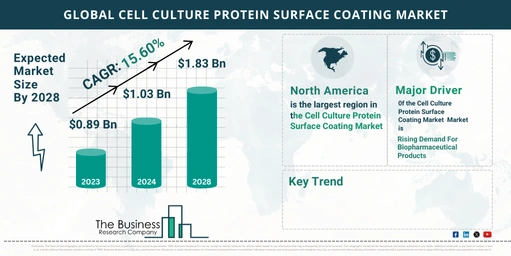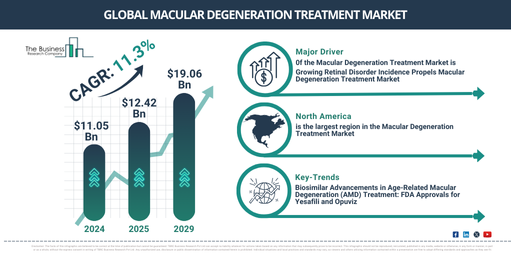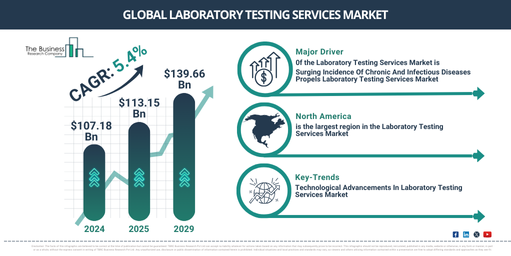Cell Culture Protein Surface Coating Global Market Outlook 2024-2033: Size And Growth Rate Analysis
The Business Research Company’s global market reports provide comprehensive analysis on the various markets in 27 industries across 60 geographies.
The cell culture protein surface coating market has experienced substantial growth in recent years, driven by advancements in biotechnology and increased research activities. Here’s an overview of its current state and future outlook.
Market Overview
- Current Growth: The cell culture protein surface coating market reached $0.89 billion in 2023. It is projected to grow to $1.03 billion by 2024, achieving a compound annual growth rate (CAGR) of 15.2%.
- Future Projections: The market is expected to expand further to $1.83 billion by 2028, with a CAGR of 15.6%.
Key Drivers of Growth
- Focus on Stem Cell Research: Increasing interest in stem cell research has significantly boosted market demand.
- Rise in Chronic Diseases: The growing prevalence of chronic diseases is driving the need for advanced cell culture techniques.
- Cell-Based Research: Enhanced focus on cell-based research contributes to the growing market.
View More On The Cell Culture Protein Surface Coating Market Report 2024 – https://www.thebusinessresearchcompany.com/report/cell-culture-protein-surface-coating-global-market-report
Factors Influencing Future Growth
- Adoption of 3D Cell Culture: The integration of 3D cell culture technologies is expected to accelerate market growth.
- Demand for Protein Therapeutics: Increased demand for protein-based therapeutics is a significant driver.
- Healthcare Spending: Rising investments in healthcare and R&D are further fueling market expansion.
- Technological Advancements: Innovations in high-throughput screening and new product launches are major trends.
Impact of Biopharmaceuticals
- Growing Demand: The rise in biopharmaceutical products, including recombinant DNA technology and monoclonal antibodies, is a key growth driver.
- Cell Culture Optimization: Protein surface coatings enhance cell growth and production efficiency, crucial for developing high-quality biopharmaceuticals.
- Market Data: As of Q1 2023, the number of cell, gene, and tissue-engineering therapeutic developers worldwide increased by 101% from the previous year, underscoring the sector’s expansion.
Major Companies and Developments
- Thermo Fisher Scientific Inc.: Acquired PeproTech, Inc. in January 2022 to bolster its recombinant protein capabilities. This acquisition aims to enhance its portfolio for supporting cell growth and biopharmaceutical development.
- Other Key Players: Includes Merck KGaA, Corning Incorporated, Avantor Inc., Agilent Technologies Inc., and several others.
Market Segmentation
- By Coating Type:
- Pre-Coating
- Multiwall or Microwell Plates
- Flasks
- Petri Dishes
- Slides
- Cover Slips
- Self-Coating
- By Protein Source:
- Animal-Derived Protein
- Human-Derived Protein
- Synthetic Protein
- Plant-Derived Protein
- By Application:
- Scientific Research
- Industrial Production
Regional Insights
- North America: The largest market region in 2023.
- Asia-Pacific: Expected to be the fastest-growing region during the forecast period.
Conclusion
The cell culture protein surface coating market is on a robust growth trajectory, driven by technological advancements, increased demand for biopharmaceuticals, and rising healthcare investments. With significant growth expected in the coming years, stakeholders and investors should keep an eye on emerging trends and regional developments to capitalize on opportunities in this dynamic market.
Request A Sample Of The Global Cell Culture Protein Surface Coating Market Report 2024:
https://www.thebusinessresearchcompany.com/sample_request?id=16369&type=smp



